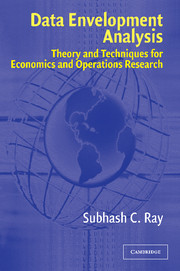Book contents
- Frontmatter
- Contents
- Preface
- 1 Introduction and Overview
- 2 Productivity Efficiency, and Data Envelopment Analysis
- 3 Variable Returns to Scale: Separating Technical and Scale Efficiencies
- 4 Extensions to the Basic DEA Models
- 5 Nonradial Models and Pareto–Koopmans Measures of Technical Efficiency
- 6 Efficiency Measurement without Convexity Assumption: Free Disposal Hull Analysis
- 7 Dealing with Slacks: Assurance Region/Cone Ratio Analysis, Weak Disposability, and Congestion
- 8 Efficiency of Merger and Breakup of Firms
- 9 Efficiency Analysis with Market Prices
- 10 Nonparametric Approaches in Production Economics
- 11 Measuring Total Productivity Change over Time
- 12 Stochastic Approaches to Data Envelopment Analysis
- 13 Looking Ahead
- References
- Index
4 - Extensions to the Basic DEA Models
Published online by Cambridge University Press: 24 November 2009
- Frontmatter
- Contents
- Preface
- 1 Introduction and Overview
- 2 Productivity Efficiency, and Data Envelopment Analysis
- 3 Variable Returns to Scale: Separating Technical and Scale Efficiencies
- 4 Extensions to the Basic DEA Models
- 5 Nonradial Models and Pareto–Koopmans Measures of Technical Efficiency
- 6 Efficiency Measurement without Convexity Assumption: Free Disposal Hull Analysis
- 7 Dealing with Slacks: Assurance Region/Cone Ratio Analysis, Weak Disposability, and Congestion
- 8 Efficiency of Merger and Breakup of Firms
- 9 Efficiency Analysis with Market Prices
- 10 Nonparametric Approaches in Production Economics
- 11 Measuring Total Productivity Change over Time
- 12 Stochastic Approaches to Data Envelopment Analysis
- 13 Looking Ahead
- References
- Index
Summary
Introduction
This chapter presents several extensions to the basic DEA models described earlier. Both the CCR and the BCC models are either output- or input-oriented. One has to choose between output expansion and input conservation as the criterion of efficiency. Of course, in the CCR model, output- and input-oriented measures of technical efficiency are identical. This is not true for the BCC model, however. Two alternative technical-efficiency measures considered in this chapter are (a) the graph hyperbolic efficiency described in Section 4.2, and (b) the directional efficiency measure described in Section 4.3. Both of these measures emphasize expanding outputs and contracting inputs simultaneously. The efficiency score computed by DEA permits us to rank-order the performance of inefficient firms. By contrast, the efficient observations are rated equally. Section 4.4 describes how one can rank observations that are all equally rated at 100% efficiency. This section also explains how one can identify influential observations in DEA. The productive performance of any firm is affected by a number of exogenously determined factors over which it has no control. In the DEA literature, such factors are treated as nondiscretionary. Section 4.5 explains how the influence of these nondiscretionary factors can be identified as shifts in the production frontier and provides the rationale for a second-stage regression analysis explaining the variation in DEA efficiency scores in terms of differences in these nondiscretionary factors.
Information
- Type
- Chapter
- Information
- Data Envelopment AnalysisTheory and Techniques for Economics and Operations Research, pp. 82 - 110Publisher: Cambridge University PressPrint publication year: 2004
